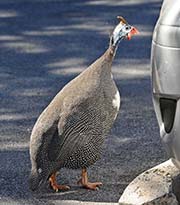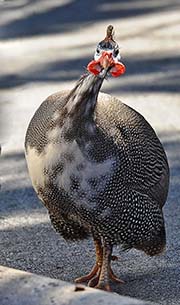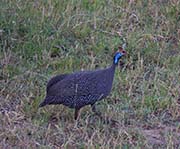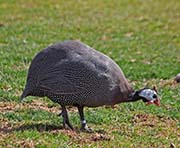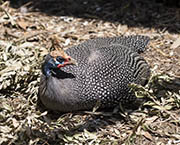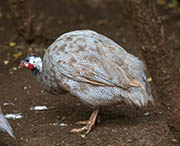Helmeted Guineafowl - Numida meleagris
| Length | |
| Weight | |
| Clutch Size | |
| Chicks at birth | |
| IUCN Conservation Status | |
Continents: |
The Helmeted Guineafowl is native to Sub-Saharan Africa. It was introduced to Madagascar, Australia, southern France, Brazil and the West Indies. There are nine subspecies of Helmeted Guineafowl.
The Helmeted Guineafowl is large bird with a plump body, small head, short legs and long toes. The body plumage is gray-black spotted with white. The head is featherless and the skin is red and blue colored. A brownish colored casque (a body projection) sticks out of the top of the head. The eyes are red, the bill is short, stout and curved and reddish wattles are found near the base of the bill. Their wings are short and rounded and Helmeted Guineafowl. They can fly short distances rapidly, but mostly use their speed on the ground to escape predators. Sexes are similar.
Helmeted Guineafowl and their eggs are considered good to eat. They are raised on farms for consumption as well as hunted in the wild.
They are at least nine sub-species of Helmeted Guineafowl and they are considered a bird of 'Least Concern' for extinction because of their numbers and wide range.
Diet: Helmeted Guineafowl eat seeds, roots, tubers, berries, flowers, grasshoppers, termites, snails and other small invertebrates.
Courtship: When not breeding, Helmeted Guineafowl are found in large flocks up to 2,000 birds. During the breeding season, after the rainy season in Africa, they break up into smaller groups. To attract a mate, males 'display' to the female. Pairs are monogamous.
Nesting: The nest is an unlined scraped depression in the ground. The male stands guard over while the female lays 6-12 eggs and is the sole incubator. Nests have been found that contain up to 50 eggs and presumably they were laid by more than one female. Both parents care for the chicks when hatched.
Habitat and Range: Helmeted Guineafowl inhabit a wide variety of habitats but prefer open country and shrub grassland. They live in large flocks except during breeding season. They prefer to hide in shrubs and bushes and roost in trees at night.
Vocalization: They are noisy birds. Males utter a one-syllable call, usually repeated several times in succession. Females utter a two-syllable call, usually repeated several times in succession Before sunset, they produce harsh, abrasive cackles while roosting in trees.
Plumage/Molt They do not have an alternate or breeding plumage.
Migration: Non-migratory.
Tongue/feet: The feet have four straight, well spread and strong toes without spurs
Bibliography:
- http://en.wikipedia.org The Free Encyclopedia, Accessed July, 2012
- http://stlzoo.org/animals/abouttheanimals/ St. Louis Zoo, Accessed July, 2012
- http://birdweb.org/birdweb Seattle Audubon Society, Accessed July, 2012
- http://www.honoluluzoo.org Honolulu Zoo, Accessed July, 2012
- Ferguson, Jeannette S., Gardening with Guineas,Morris Publishing, 1999
